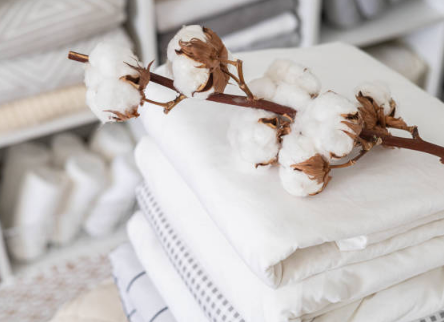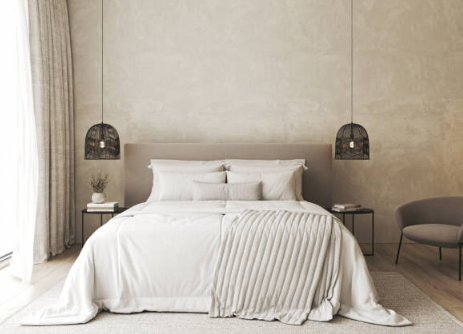
Living Room Wallpaper Ideas That Show Off Design Style
February 5, 2025
15 Timeless Living Room Color Schemes You’ll Love
February 12, 2025A bed can last a lifetime, but bed sheets can’t do the same thing. Sheets can last for a few years, depending on the frequency of use and cleaning habits. However, this also largely depends on the quality of the material.
Rotating between sheet sets and maintaining proper storage can prevent your favorites from showing visible signs of replacement such as discoloration, thinning, and wear and tear. Here are what experts say about the lifespan of your sheets and your recommendations for extending your linen lifespan.

Bed Linen Life Expectancy
Rex Isap, CEO of Happy Beds, said:”Sheets typically last between 2 and 5 years, influenced by care, weaving and materials. ”
However, Parima Ijaz, CEO of Pure Parima, says that certain luxury bedding, such as Egyptian cotton, can last for 10 years or more. “The lifespan of a sheet really depends on the quality, the material, the use and the care,” Ijaz says. “If you choose high-end, high-quality linens and take proper care of them according to the care instructions, you can have reliable, durable bedding that will allow you to sleep soundly for many nights to come. ”
Since many factors determine the lifespan of a sheet, it is best to take into account the desired time frame when making a purchase. “Some fabrics, such as linen and polyester, don’t store well after multiple washes and may start to deteriorate faster, leading to more replacement,” Ijaz said.
Considering the material, weave, and care instructions when buying can help you determine if the price matches the value.

Factors That Determine the Lifespan of Bed Sheets
Care and cleaning: Each set of sheets comes with care instructions that few people read. The type of detergent, temperature setting, and drying instructions can vary greatly between different sheet sets. It’s best to follow the recommended steps to get the most out of your sheets.
Frequency of use: A lot depends on how often you sleep on your sheets. Whether you’re a frequent traveler or rotate multiple sets of bedding frequently, how often you use and wash your sheets can have a significant impact on how long your sheets will last.
Yarn count: Yarn count refers to the number of yarns per square inch of fabric. This thread count plays an important role in determining the quality of the fabric. More than 400 threads is fine, but you may find that some ads have up to 2000 threads on them. It’s easy to think that the higher the number of threads, the higher the quality. However, most bedding experts say that anything over $600 is likely to be just a ploy to inflate the price, and few notice the difference in sleep quality.
Type of material: Sheets are made of different materials, and the strength of the fibers determines their longevity. Synthetic materials such as polyester usually have a lifespan of about two to three years, which is shorter than natural materials.
“A blend of natural and synthetic fibers falls somewhere between these two extremes and can have an intermediate lifespan of about three to four years if properly cared for,” says Isap.

Weaving: Isap explains that a denser weave can create a smoother, stronger fabric that can withstand repeated washing and use without frating or weakening. Plain tissue is the most common. They divide the horizontal and vertical lines evenly to provide equal pulling force. Braids that use more vertical yarns can produce silkier fabrics, such as satin, but they can cause fluffing.
Ways to Extend the Life of Your Sheets
Buy quality sheets: Quality sheets have strong fibers that can withstand frequent use, washing, and drying. The best quality panels include bamboo, tencel, cotton, cale weave, cotton sateen, and linen. High-quality natural materials tend to last the longest.
Proper maintenance: Some very nasty things can accumulate on the sheets over time. Dust mites, allergens, body oils, moisture, dead skin cells, and other fabric-feeding insects can quickly ruin your favorite bedding. Follow the manufacturer’s guidance to maintain the cleanliness, color, and elasticity of your sheets.
Store properly: Store your sheets in a dry, well-ventilated place when not in use. Try using a dedicated bin, a breathable bag, or a well-ventilated linen closet. Line the storage area with acid-free tissue paper to prevent yellowing. Please note that sealed plastic storage bins may become moldy and damp.

Use multiple sets: Frequent washing can make the sheets wear out quickly. However, rotating between two or more groups can extend the lifespan of all groups. Consider buying more than one set of sheets and rotating them weekly. Doing so ensures a long service life for each group.
Signs Indicate That It’s Time to Change the Sheets
After regular use and wash cycles, the sheet fibers will begin to break down and show signs of wear. But how exactly do you know if it’s time for a new collection?
Isap recommends keeping an eye out for frayed edges, thinning fabrics, holes that appear, fading, and fluffing – those little hairballs on the surface of the fabric. Sheets that were once soft may feel rough or uncomfortable after repeated washing, which may reduce the quality of sleep. In addition to unexplained skin reactions, he says, “lingering odors occur even after washing, or a lack of fresh odors, which may indicate that the sheets are in their best condition.” ”
Otherwise, any signs of yellowing, discoloration, fading, stubborn stains, fabric thinning, and mold or fungal odors mean it’s time to replace your most beloved sheets.



